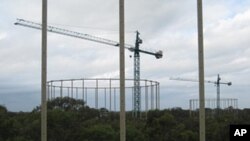One of the world’s most complex experiments on the impact of rising levels of carbon dioxide is taking shape in eastern Australia, where giant steel frames nine stories high have been built on native woodland. The project near Sydney will mimic future climatic conditions by simulating higher atmospheric concentrations of carbon dioxide.
Measuring carbon dioxide
Carbon dioxide is pumped into an environmental “time machine” on the outskirts of Sydney, aiming to predict how vegetation will react to future climate change.
The experiment features giant cylindrical steel frames 28 meters tall that rise above native woodland, called bushland. They will simulate elevated levels of CO2 that the planet could experience in the next half century.
Professor David Ellsworth from the University of Western Sydney is in charge of this unique project. “We have six of these arrays of pipes up in the woodland designed to emit carbon dioxide in a computer-controlled system so we can study how this ecosystem responds a rising atmospheric carbon dioxide concentration,” he said.
It has taken researchers a year to build this industrial-looking ecological experiment, which will last for a decade.
The university says it is the world’s biggest outdoor carbon dioxide trial, and the only one to use mature woodland.
“My name is Steven Wohl from the University of Western Sydney. I am the senior engineering officer for the EucFace site. Where we are going up now is a 22-meter tall modular scaffolding placed in the center of the ring," he explained. "It allows us to place instrumentation at different heights in the canopy and also gives the researchers a unique perspective of the canopy.”
Long-term project, research
Professor Ellsworth says the research, which will last for a decade, will give policy makers more information about how to plan for future climate change. “We’re hoping to find out how this ecosystem actually responds to carbon dioxide concentration of the future, and whether it will actually store more carbon or not. That’s really important from the standpoint of native bush in Australia which occupies a very large part of our land mass,” he noted.
Australia’s large tracts of undeveloped land, known as bush, are a key part of plans to store carbon emissions. How much carbon the ecosystem can absorb is a key question for the country’s future.
“If native bush is not able to do more than it currently does at the present day, then we need to know that pretty urgently. I think,” said Ellsworth.
Ian Anderson is a director of research at the University of Western Sydney, which has a range of studies looking at shifting levels of carbon dioxide.
“Most of our experiments are aimed at looking at in the order of 30-50 years ahead based on predictions, so our CO2 concentrations and our temperature treatments are based around looking ahead to that sort of timeframe. We also have the experimental facilities to actually look back in time," said Anderson. "So we can actually take CO2 out of the atmospheres in some of our controlled environment rooms and look at how those plants would’ve responded back in time, I guess to build up a bit of a picture of where they’ve been, where we are now and where we are going to go to in the future.”
Funded by taxpayers, the government says these experiments will transform climate change research in Australia, which emits more greenhouse gas pollution per person than anywhere else in the developed world.







